“Strive to become a key player, an outstanding contributor and an active leader of the country’s carbon peak and carbon neutrality initiative”. On June 13, at the opening of the 32nd National Energy Saving Publicity Week, Song Xin, Party Secretary and Chairman of CECEP, announced the vision, actions and initiatives of CECEP on green and low-carbon development.
The dual carbon goals represent an uphill battle. As a player of the “national team” and a “key enabler” of energy conservation and environmental protection, CECEP has been committed to “making the sky bluer, the mountains greener, the water cleaner and the life better” and taken it as its mission, earnestly met the requirements of ecological civilization construction and the national dual strategic carbon goals, actively practiced the concept of green development, deeply cultivated in green and low-carbon industries, and set the goal of serving the dual carbon goals in the New Era.
Focus on the objectives and fully leverage the intellectual resources in achieving the dual carbon goals
Facing the new tasks and requirements, CECEP put forward the vision of “becoming a world-class solution provider in carbon peak and carbon neutrality by 2030”, and actively built the “3+3+1” industrial structure with energy conservation and clean energy supply, eco-environmental protection and life and health as its three core business segments, green building, green new materials and green engineering services as its three major business segments, underpinned by strong strategic support.

In 2021, CECEP developed the Action Plan for Carbon Peak and Carbon Neutrality, built the “1+3+3” strategic plan for achieving the dual carbon goals, and set the timetable and road map hereof. All business segments of its whole system share the same goal, synergize with each other on multiple fronts with the aim of building new comprehensive energy services, strengthen advantages, promote synergy of pollution reduction and carbon reduction, and deepen research in order to better use intellectual resources to attain the dual carbon goals.
In February this year, China National Environmental Protection Group(CNEPC), a subsidiary of CECEP, together with China Huaneng Group, completed the first carbon asset transaction of BCCER in China in Hubei Carbon Emissions Trading Center system, marking the beginning of CECEP’s active research and cooperation on blockchain and carbon certification.
Since the beginning of this year, the research and consultation on carbon peak and carbon neutrality, such as the Comparative Study on the Path of Methane Emission from China’s Coal Industry into the Carbon Market and the Promotion of Carbon Accounting Methods in China’s Financial Industry undertaken by CECEP, and the Study on the Price Policy System of Guizhou Province to Achieve Carbon Peak and Carbon Neutrality and Resolutely Fighting against Pollution, have testified the fruitful results of CECEP’s think tank in this area.
Over the years, CECEP has all along provided professional and technical support for the formulation of relevant national policies and standards, undertaken more than 20 national policy studies such as the National Key Energy Conservation Technology Promotion Catalogue, the National Key Low-carbon Technology Promotion Catalogue and the National Green Technology Promotion Catalogue, and compiled and published the first voluntary classification standard of climate investment and financing in China, the Classification Guide for Climate Investment and Financing Projects. It actively formulated carbon-related standards or schemes for 10 regions, such as Beijing, Chongqing and Yangtze River Delta Integration Demonstration Zone, and support local dual carbon practices; it also carried out the study of dual carbon pathways and cases for central SOEs and provided relevant consulting services to more than 20 central SOEs and financial institutions.
Deeply Focus on the main business and constantly explore green and low-carbon development pathways
On May 13, the first integrated protection and restoration project of mountains, rivers, forests, fields, lakes, grass and sand in the key source area of Tarim River in Xinjiang (Aksu River Basin), kicked off in Aksu. It is planned to invest 5 billion yuan in three years to fully transform and upgrade the ecological environment of Aksu River Basin. As the main builder of this project, the employees of CECEP are working pretty hard everywhere on the project construction site.
Over the years, CECEP has focused on the dual carbon tasks and goals, and has been committed to its main business, with a pioneering and innovative spirit as well as a down-to-earth attitude, kept exploring a pathway to achieve the coordinated development of the green economy, constantly innovating the green and low-carbon business model, sticking to and carrying forward the green development concept, so that low-carbon industries can blossom everywhere, take root and sprout, in order to underpin the regional green development and low-carbon transformation.
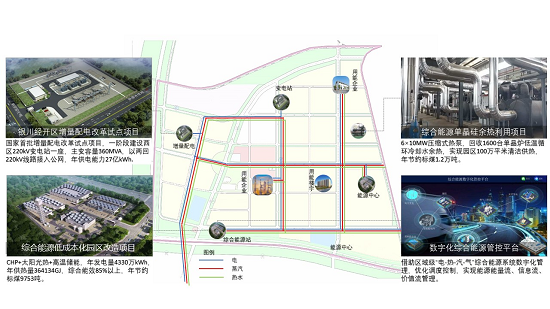
The dual carbon action chart of a joint power project, led by the pilot project of incremental power distribution reform in the Economic Development Zone of Yinchuan, Ningxia
In Yinchuan, Ningxia, CECEP has built an integrated energy project covering 5.7 square kilometers of power supply area, five square kilometers of heating area and 2.7 billion kilowatt-hours of annual power supply, provided integrated energy such as cold, heat, steam and electricity for Yinchuan’s Economic Development Zone. CECEP applied its digital platform for integrated energy service, which is independently developed on its own and can manage users’ cold, heat, water, electricity, gas and other energy sources in the zone and the optimal scheduling of all kinds of energy supply equipment, and it can also turn the zone into a demonstrative integrated energy and industrial park with integrated, smart, safe, innovative, low-carbon and energy-saving features, thus effectively revolutionized energy production and consumption, and created a clean, low-carbon, safe and efficient energy system.
This project is a microcosm of CECEP’s integrated energy-saving and carbon-reducing services for industrial parks by providing advanced integrated energy utilization technology and iterative innovation of carbon-related technology products and services, starting from the coordinated coupling of the whole energy network of “source, network, charge and storage”, under the guiding concept of “multi-energy complementarity, integrated energy supply and smart operation”.
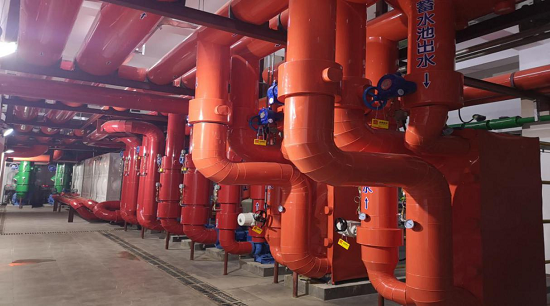
Integrated energy supply system and sewage treatment system of Xiong’an Citizen Service Center
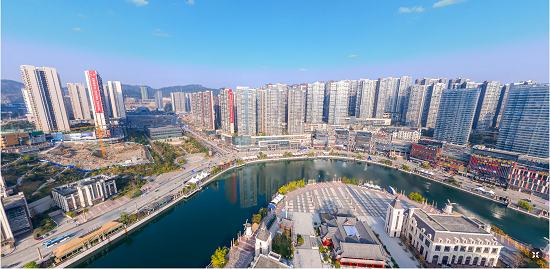
Guiyang Future Ark Cooling and Heating Project with Renewable Energy
As the pioneer of regional energy supply in the South, the explorer of clean heating in the North, and the practitioner of zero-carbon energy supply in China, CECEP vigorously promotes the large-scale application of regional energy characterized by “efficient conversion of low-grade renewable energy”, “gradient utilization”, “multi-energy complementarity” and “integrated optimization”, and strives to build a number of projects such as the Integrated Energy Project in Xiong’an Citizen Service Center, Guiyang Future Ark Cooling and Heating Project with Renewable Energy, Changzhou High-speed Railway New City Smart Integrated Energy Station, etc., with a total planned area of clean energy supply exceeding 160 million square meters, and the service area exceeding 64 million square meters. In 2021, the total energy supply area was 18.1 million square meters. Compared with the traditional energy supply mode, the annual energy saving amount was 1.32 million GJ, equivalent to 134,000 tons of standard coal, thus reduced carbon emissions maximally.
Being committed to green and low-carbon clean energy, and many years of efforts have been paid off. Recently, its solar energy company CECEP Solar has won the bid for the 1 GW base project in North Tashan, Beijiang of Xinjiang Corps by a consortium. According to the tripartite agreement of the consortium bid, CECEP Solar will allocate 200 megawatts of photovoltaic quota, which will generate about 420 million kilowatt-hours of green electricity per year. Compared with coal-fired power plants of the same scale, it can save about 128,000 tons of standard coal, reduce about 411,000 tons of carbon dioxide and 1,849.2 tons of soot per year.
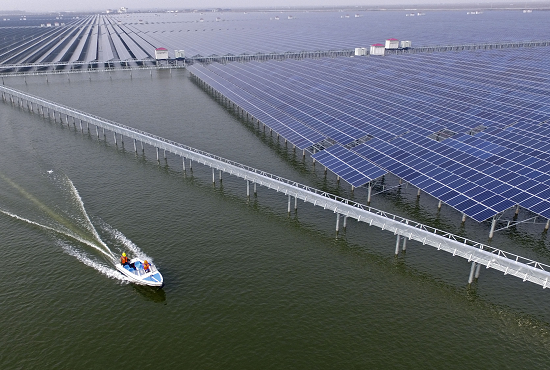
CECEP 200 MW fishing-light complementary photovoltaic power generation project in Cixi, Zhejiang
As a demonstrator and leader of green power development, CECEP has actively explored a new way of managing photovoltaic power station featured by integrating photovoltaic and agriculture, integrating forestry, ecology and governance, established a multi-industry integrated development mode of “power generation over farmland” with tangible ecological benefits. Additionally, efforts have been made to implement major national strategies such as the construction of Guangdong-Hong Kong-Macao Greater Bay Area, the protection of Yangtze River, the ecological protection of the Yellow River Basin, the coordinated development of Beijing-Tianjin-Hebei Region, the construction of Qinghai New Energy Industry Base and Zhangjiakou New Energy Demonstration Zone, etc., and a model of “wind power+ecological protection”, “wind power+carbon sink”, “wind power+industry poverty alleviation” and integration of wind and energy storage has been formed, thus promoted the construction of ecological civilization and upgraded new energy industry. It is worth mentioning that during the 2022 Winter Olympics in Beijing, CECEP, as the supplier of green electricity for the Olympics, has successfully completed the service guarantee of green electricity for the Olympics with zero failure and zero hidden dangers, and fulfilled the solemn promise of completely neutralizing carbon emissions for the 2022 Winter Olympics in Beijing with practical actions.
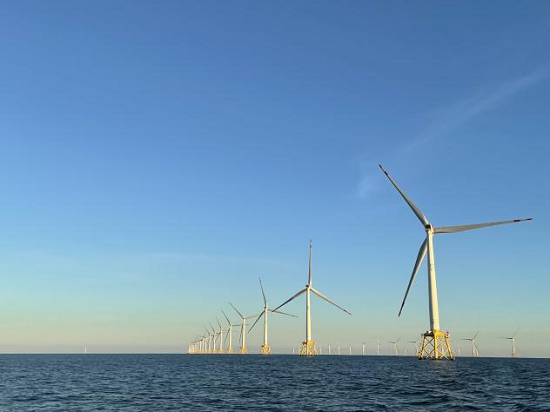
CECEP 300 MW offshore wind power project in Nanpeng Island of Yangjiang, Guangdong
Up to now, the installed capacity of CECEP’s green power is 14.442 million kilowatts, and the power generation is 9.23 billion kilowatt hours, which is equivalent to reducing carbon dioxide emissions by 7.029 million tons, saving 2.819 million tons of standard coal, and continuously contributing to the national goal of pollution and carbon reduction.
Enhance the driving force of science and technology and turbocharge the green and low-carbon transformation and development
On June 9, with the full launch of the CECEP Zero Carbon Building 1.0 Project, it marked that CECEP Industry Development Co., Ltd., a subsidiary of CECEP, carried out the iterative upgrading of zero carbon technology on the basis of the original Green Triple Star, making the birth of the first batch of zero carbon demonstration buildings in China. As the operator of China’s green eco-city development, CECEP Industry Development has continuously promoted innovation, upgraded the iteration of green building products, gradually identified the development pathway of expanding from one building to one zone and one city, achieved the leap-frog development of zone from low-carbon to zero-carbon, and realized the transformation from simply saving energy to low-carbon and green development. It has made outstanding contributions to promoting the regional green and low-carbon development, the agglomeration and upgrading of energy conservation and environmental protection industries. And its energy conservation solutions are active agents to attain the dual strategic goals of carbon peak and carbon neutrality.
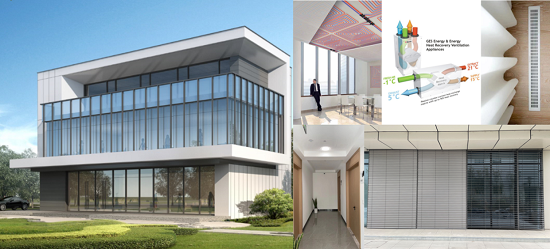
Building No. 63, Unit 14-01 (Phase II), CECEP (Zhuji) Environmental Protection Industrial Park, Zhejiang
Green technology brings high efficiency and energy savings. “CECEP Energy-saving Cloud Platform” is an intelligent manufacturing system independently developed by CECEP Solar. Without relying on manual work, cloud computing can enable AGV cars to automatically receive tasks and deliver them accurately. Cloud computing can also identify the ultra-high definition image, carry out quality inspection, achieve paperless production, increase production capacity by 50.7% and efficiency by 15%. The platform has been fully applied to 31 photovoltaic power stations, and the monitored power generation this year has reached 980 million kWh, which is equivalent to 390,000 tons of standard coal saved, 150 million trees planted, 972,000 tons of CO2 and 29,000 tons of SO2 emissions reduced.
The “Energy Efficiency Expert Management Platform” is an intelligent system of energy-saving and low-carbon energy stations built by CECEP Building Energy Conservation Co., Ltd., a subsidiary of CECEP. Starting from the demand side, the system can predict the user load fluctuation in real time, simulate the whole process of regional energy system, take into account the reliability, stability, flexibility and fault tolerance of the system, compare the operation status of each scheme, quickly complete the analysis of the load distribution scheme and operation control strategy of regional energy system with one button, and realize the optimal scheduling operation of “source, network, load and storage” based on Bayes intelligent early warning and response technology. The system has been granted with 2 invention patents, 13 utility model patents, 9 software copyrights, and it complied two group technical standards as chief editor and 6 group technical standards as participants.
The transformation of economic growth mode to green and low carbon has become the only choice for the development of human society. On this arduous and long journey of green development, CECEP, as the leader and pioneer of energy conservation, emission reduction and environmental protection, is given the mission to promote the integrated green and low-carbon transformation of economic and social development. Going forward, it will shoulder its responsibility as a central SOE, constantly improve on the green and low-carbon front for energy conservation and environmental protection, prioritize ecological and green development, further improve its capacity of serving the national dual carbon strategy, and contribute to the green and low-carbon transformation and socioeconomic development with concrete action.